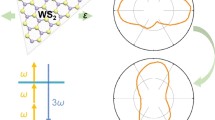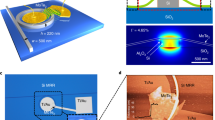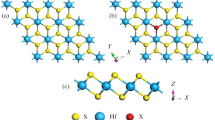Abstract
The photogalvanic effect (PGE) occurring in noncentrosymmetric materials enables the generation of a dc photocurrent at zero bias with a high polarization sensitivity, which makes it very attractive in photodetection. However, the magnitude of the PGE photocurrent is usually small, leading to a low photoresponsivity, and therefore hampers its practical application in photodetection. Here, we propose an approach to largely enhancing the PGE photocurrent by applying an inhomogenous mechanical stretch, based on quantum transport simulations. We model a two-dimensional photodetector consisting of the wide-bandgap MgCl2/ZnBr2 vertical van der Waals heterojunction with the noncentrosymmetric C3v symmetry. Polarization-sensitive PGE photocurrent is generated under the vertical illumination of linearly polarized light. By applying inhomogenous mechanical stretch on the lattice, the photocurrent can be largely increased by up to 3 orders of magnitude due to the significantly increased device asymmetry. Our results propose an effective way to enhance the PGE by inhomogenous mechanical strain, showing the potential of the MgCl2/ZnBr2 vertical heterojunction in the low-power UV photodetection.

Similar content being viewed by others
References
H. Chen, H. Liu, Z. Zhang, K. Hu, and X. Fang, Nanostructured photodetectors: From ultraviolet to terahertz, Adv. Mater. 28(3), 403 (2016)
Q. Zhang, X. Li, Z. He, M. Xu, C. Jin, and X. Zhou, 2D semiconductors towards high-performance ultraviolet photodetection, J. Phys. D 52(30), 303002 (2019)
D. Guo, Y. Su, H. Shi, P. Li, N. Zhao, J. Ye, S. Wang, A. Liu, Z. Chen, C. Li, and W. Tang, Self-powered ultraviolet photodetector with superhigh photoresponsivity (3.05 A/W) based on the GaN/Sn:Ga2O3 pn Junction, ACS Nano 12(12), 12827 (2018)
W. Zheng, R. Lin, Y. Zhu, Z. Zhang, X. Ji, and F. Huang, Vacuum ultraviolet photodetection in two-dimensional oxides, ACS Appl. Mater. Interfaces 10(24), 20696 (2018)
W. Zheng, R. Lin, Z. Zhang, and F. Huang, Vacuum-ultraviolet photodetection in few-layered h-BN, ACS Appl. Mater. Interfaces 10(32), 27116 (2018)
Y. Gao, S. Lei, T. Kang, L. Fei, C. L. Mak, J. Yuan, M. Zhang, S. Li, Q. Bao, Z. Zeng, Z. Wang, H. Gu, and K. Zhang, Bias-switchable negative and positive photoconductivity in 2D FePS3 ultraviolet photodetectors, Nanotechnology 29(24), 244001 (2018)
H. Kan, W. Zheng, R. C. Lin, M. Li, C. Fu, H. B. Sun, M. Dong, C. H. Xu, J. T. Luo, Y. Q. Fu, and F. Huang, Ultrafast photovoltaic-type deep ultraviolet photodetectors using hybrid zero-/two-dimensional heterojunctions, ACS Appl. Mater. Interfaces 11(8), 8412 (2019)
Y. Gao, Y. Zhang, and D. Xiao, Tunable layer circular photogalvanic effect in twisted bilayers, Phys. Rev. Lett. 124(7), 077401 (2020)
R. von Baltz and W. Kraut, Theory of the bulk photovoltaic effect in pure crystals, Phys. Rev. B 23(10), 5590 (1981)
V. I. Belinicher, Space-oscillating photocurrent in crystals without symmetry center, Phys. Lett. A 66(3), 213 (1978)
S. D. Ganichev and W. Prettl, Spin photocurrents in quantum wells, J. Phys.: Condens. Matter 15(20), R935 (2003)
X. Tao, P. Jiang, H. Hao, X. Zheng, L. Zhang, and Z. Zeng, Pure spin current generation via photogalvanic effect with spatial inversion symmetry, Phys. Rev. B 102(8), 081402 (2020)
M. M. Ramin Moayed, F. Li, P. Beck, J. C. Schober, and C. Klinke, Anisotropic circular photogalvanic effect in colloidal tin sulfide nanosheets, Nanoscale 12(11), 6256 (2020)
M. Chen, K. Lee, J. Li, L. Cheng, Q. Wang, K. Cai, E. E. M. Chia, H. Chang, and H. Yang, Anisotropic picosecond spin-photocurrent from Weyl semimetal WTe2, ACS Nano 14(3), 3539 (2020)
C. Guo, Y. Hu, G. Chen, D. Wei, L. Zhang, Z. Chen, W. Guo, H. Xu, C. N. Kuo, C. S. Lue, X. Bo, X. Wan, L. Wang, A. Politano, X. Chen, and W. Lu, Anisotropic ultrasensitive PdTe2 -based phototransistor for room-temperature long-wavelength detection, Sci. Adv. 6(36), eabb6500 (2020)
Y. Luo, Y. Hu, and Y. Xie, Highly polarization-sensitive, visible-blind and self-powered ultraviolet photodetection based on two-dimensional wide bandgap semiconductors: A theoretical prediction, J. Mater. Chem. A 7(48), 27503 (2019)
Y. Peng, X. T. Liu, Z. H. Sun, C. M. Ji, L. N. Li, Z. Y. Wu, S. S. Wang, Y. P. Yao, M. C. Hong, and J. H. Luo, Exploiting the bulk photovoltaic effect in a 2D trilayered hybrid ferroelectric for highly sensitive polarized light detection, Angew. Chem. Int. Ed. 59(10), 3933 (2020)
Y. J. Zhang, T. Ideue, M. Onga, F. Qin, R. Suzuki, A. Zak, R. Tenne, J. H. Smet, and Y. Iwasa, Enhanced intrinsic photovoltaic effect in tungsten disulfide nanotubes, Nature 570(7761), 349 (2019)
J. E. Spanier, V. M. Fridkin, A. M. Rappe, A. R. Akbashev, A. Polemi, Y. Qi, Z. Gu, S. M. Young, C. J. Hawley, D. Imbrenda, G. Xiao, A. L. Bennett-Jackson, and C. L. Johnson, Power conversion efficiency exceeding the Shockley-Queisser limit in a ferroelectric insulator, Nat. Photonics 10(9), 611 (2016)
J. Li and P. M. Haney, Circular photogalvanic effect in organometal halide perovskite CH3NH3PbI3, Appl. Phys. Lett. 109(19), 193903 (2016)
M. M. Yang, D. J. Kim, and M. Alexe, Flexo-photovoltaic effect, Science 360(6391), 904 (2018)
H. Zou, C. Zhang, H. Xue, Z. Wu, and Z. L. Wang, Boosting the solar cell efficiency by flexo-photovoltaic effect? ACS Nano 13(11), 12259 (2019)
S. Nadupalli, J. Kreisel, and T. Granzow, Increasing bulk photovoltaic current by strain tuning, Sci. Adv. 5(3), eaau9199 (2019)
J. Zhao, Y. Hu, Y. Xie, L. Zhang, and Y. Wang, Largely enhanced photogalvanic effects in a phosphorene photodetector by strain-increased device asymmetry, Phys. Rev. Appl. 14(6), 064003 (2020)
N. Mounet, M. Gibertini, P. Schwaller, D. Campi, A. Merkys, A. Marrazzo, T. Sohier, I. E. Castelli, A. Cepellotti, G. Pizzi, and N. Marzari, Two-dimensional materials from high-throughput computational exfoliation of experimentally known compounds, Nat. Nanotechnol. 13(3), 246 (2018)
G. Kresse and J. Furthmüller, Efficient iterative schemes for ab initio total-energy calculations using a plane-wave basis set, Phys. Rev. B 54(16), 11169 (1996)
G. Kresse and D. Joubert, From ultrasoft pseudopotentials to the projector augmented-wave method, Phys. Rev. B 59(3), 1758 (1999)
J. P. Perdew, K. Burke, and M. Ernzerhof, Generalized gradient approximation made simple, Phys. Rev. Lett. 77(18), 3865 (1996)
J. Taylor, H. Guo, and J. Wang, Ab initio modeling of quantum transport properties of molecular electronic devices, Phys. Rev. B 63(24), 245407 (2001)
L. E. Henrickson, Nonequilibrium photocurrent modeling in resonant tunneling photodetectors, J. Appl. Phys. 91(10), 6273 (2002)
Y. Xie, M. Chen, Z. Wu, Y. Hu, Y. Wang, J. Wang, and H. Guo, Two-dimensional photogalvanic spin-battery, Phys. Rev. Appl. 10(3), 034005 (2018)
Y. Xie, L. Zhang, Y. Zhu, L. Liu, and H. Guo, Photogalvanic effect in monolayer black phosphorus, Nanotechnology 26(45), 455202 (2015)
J. Chen, L. Zhang, L. Zhang, X. Zheng, L. Xiao, S. Jia, and J. Wang, Photogalvanic effect induced fully spin polarized current and pure spin current in zigzag SiC nanoribbons, Phys. Chem. Chem. Phys. 20, 26744 (2018)
L. Zhang, K. Gong, J. Chen, L. Liu, Y. Zhu, D. Xiao, and H. Guo, Generation and transport of valley polarized current in transition metal dichalcogenides, Phys. Rev. B 90, 195428 (2014)
V. I. Belinicher and B. I. Sturman, The photogalvanic effect in media lacking a center of symmetry, Sov. Phys. Usp. 23(3), 199 (1980)
S. D. Ganichev, H. Ketterl, W. Prettl, E. L. Ivchenko, and L. E. Vorobjev, Circular photogalvanic effect induced by monopolar spin orientation in p-GaAs/AlGaAs multiple-quantum wells, Appl. Phys. Lett. 77(20), 3146 (2000)
Acknowledgements
This work was supported by the National Natural Science Foundation of China under Grant No. 51871156.
Author information
Authors and Affiliations
Corresponding author
Additional information
arXiv: 2106.13526. This article can also be found at http://journal.hep.com.cn/fop/EN/https://doi.org/10.1007/s11467-021-1093-6.
Rights and permissions
About this article
Cite this article
Qian, L., Zhao, J. & Xie, Y. Enhanced photogalvanic effect in the two-dimensional MgCl2/ZnBr2 vertical heterojunction by inhomogenous tensile stress. Front. Phys. 17, 13502 (2022). https://doi.org/10.1007/s11467-021-1093-6
Received:
Accepted:
Published:
DOI: https://doi.org/10.1007/s11467-021-1093-6




